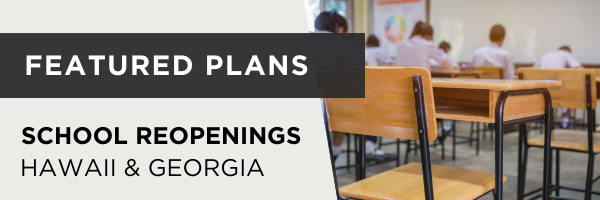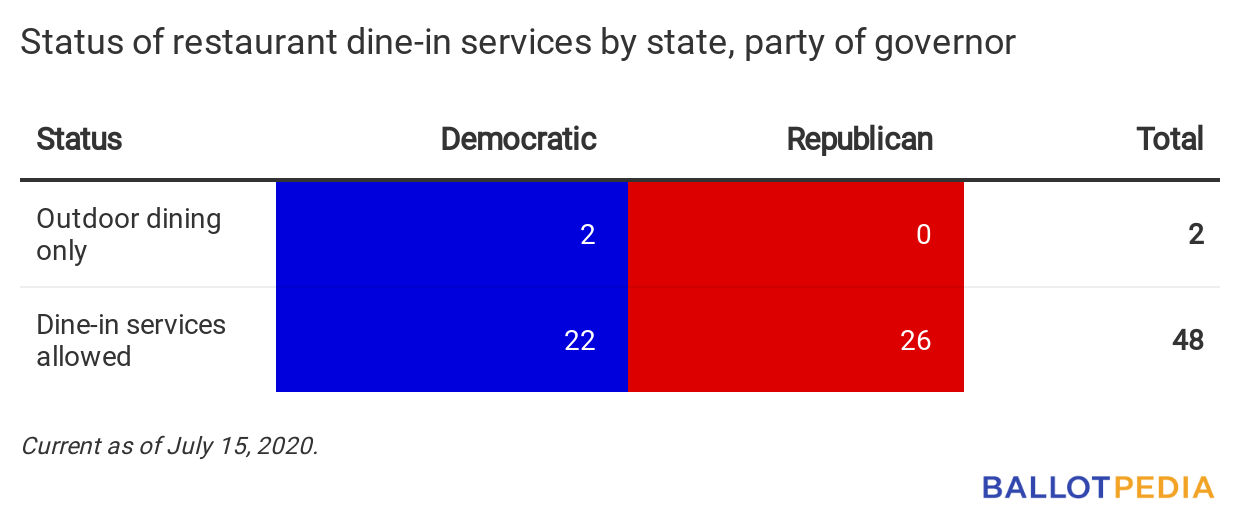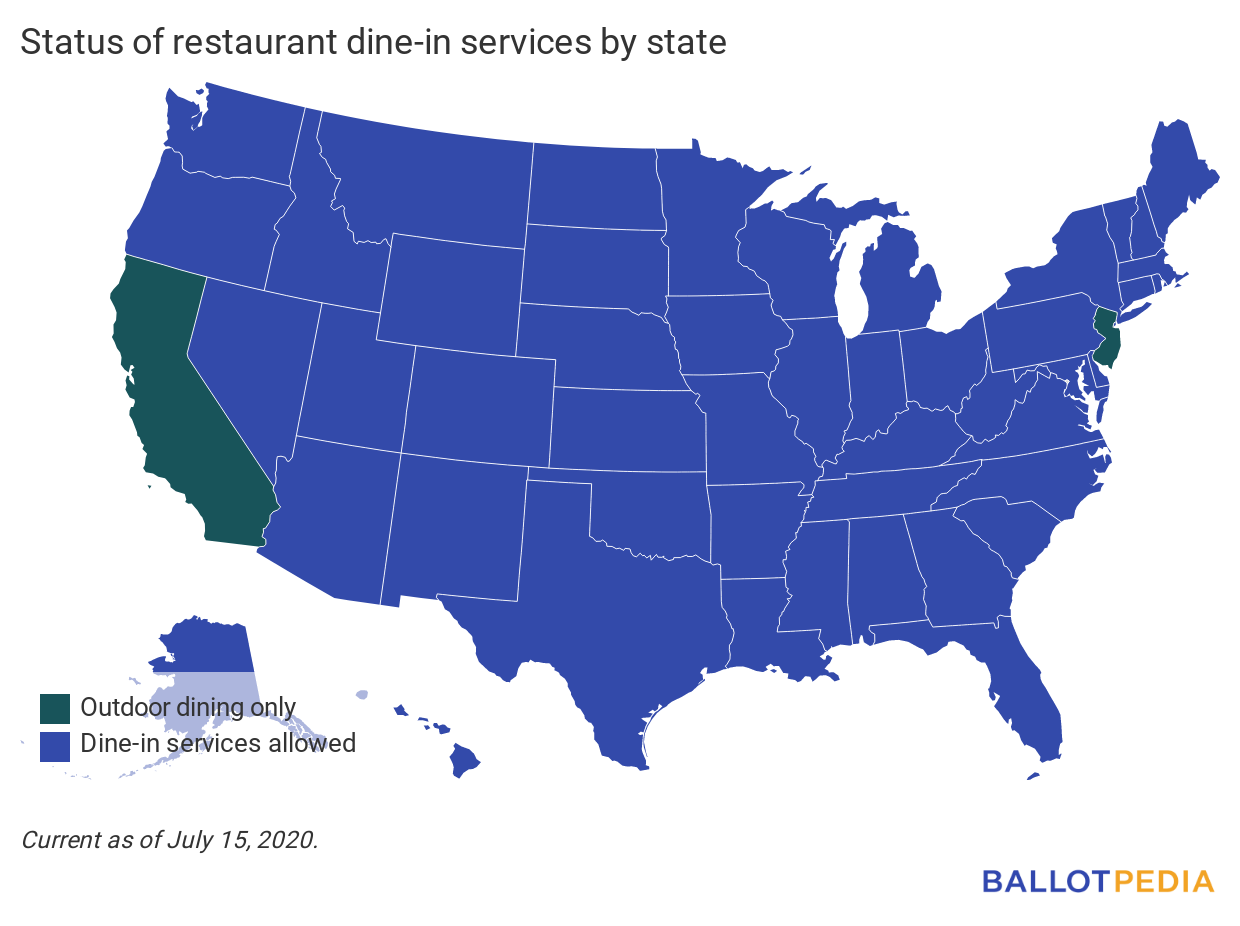Each day, we:
Want to know what happened yesterday? Click here. Since our last editionWhat is open in each state? For a continually updated article on reopening status in all 50 states, click here. For our last edition, click here.
Tracking industries: RestaurantsAll 50 states are reopening in some way. Here, we give the status of one industry or activity across the states. Today’s question: in which states may you dine in at a restaurant? We last looked at restaurants in the June 10th edition of the newsletter. Since then, seven states (Connecticut, Illinois, Massachusetts, Maryland, New Hampshire, New York, and West Virginia) have allowed for indoor dining at restaurants. One state (New Jersey) moved from allowing no dine-in services to allowing outdoor dining. One state (California) moved from allowing indoor dining to allowing only outdoor dining.
|
||||||||||||||||||||||||||||||||||||||||||||||||||||||||||||||||||||||||||||||||||||

This is an in-depth summary of two state plans to reopen public K-12 schools for the 2020-2021 school year. Hawaii’s Return to Learn planThe Hawaii Department of Education released school reopening guidance on July 2. Superintendent Christina Kishimoto said, “We know that the delivery of instruction in Hawaiʻi, the nation and the world, is going to look very different. Our HIDOE ʻohana has been diligently working on plans for the new school year, growing from this experience and applying lessons learned toward our commitment to equity of access and quality education.” On March 16, Gov. David Ige (D) extended spring break through March 27. On March 19, he closed schools through April 6. He extended the closure on March 24 through April 30. On April 17, the Department of Education closed schools for the rest of the school year. Hawaii’s 2020-2021 school year is scheduled to start on August 4. According to EdWeek, traditional public schools in Hawaii typically start the academic year in early August. The state’s school guidance is tied to the state’s general reopening plan. In-person instruction cannot fully reopen until the state enters the Recovery phase of reopening. The school plan contained the following graphic: ContextHawaii is a Democratic trifecta. The governor is a Democrat, and Democrats hold majorities in both chambers of the state legislature. The state became a Democratic trifecta in 2011. The following tables show public education statistics in Hawaii, including a rank comparing it to the other 49 states. Rank one is the highest number of each figure, rank 50 is the lowest. All data comes from the Common Core of Data provided by the National Center for Education Statistics.
DetailsDistrict reopening plans Hawaii’s school reopening plan does not discuss a need for school districts to develop their own plans or submit such plans to the state. Schools must reopen in compliance with the state’s plan. In-person, hybrid, and online learning The Department of Education said instruction will be delivered through in-person, blended, and online channels, depending on the threat presented by the coronavirus and the department’s resources. The Board of Education passed a resolution on June 18 asserting online and hybrid attendance is equivalent to in-person attendance for the purposes of fulfilling the state’s 180 instructional day requirement. Parents of children from grades 6-12 will be able to select a virtual-only learning option. The state is still developing a virtual solution for grades K-5. Full details are not yet available. Hawaii’s three multi-track schools (Mililani Middle, Kapolei Middle, and Holomua Elementary schools) will convert to a traditional, single-track schedule at least through the Fall semester. Mask requirements Students and faculty are required to wear masks when they are not in the classroom. Students and faculty generally are not required to wear masks in classrooms, but staff and other adults are required to wear masks when they are within three feet of each other or a child. For students, “Masks should be worn when keeping six feet apart is not possible, or when children face each other and interact in similar ways. However, if students are sitting three feet apart, and facing the same way, wearing a mask is not required.” In-person health recommendations and requirements The state outlined the following general guidelines for schools:
For comprehensive guidelines, click here. Transportation and bussing requirements and restrictions The Student Transportation Services Branch is working with school administrators and bus contractors to develop adjusted, school-specific arrival and departure schedules. All bus passengers will be required to wear masks. No more than two students will be able to sit in the same bench seat, and seating will be assigned. Heightened cleaning and disinfecting procedures will be implemented between bus trips. Georgia’s Path to Recovery for K-12 SchoolsOn June 1, the Georgia Department of Education, in partnership with the Georgia Department of Health, released “Georgia’s K-12 Recovery Plan,” a set of guidelines to help schools reopen for the 2020-2021 school year. State School Superintendent Richard Woods said, “We created these guidelines, in partnership with Dr. Kathleen Toomey and her team at the Georgia Department of Public Health, to give school districts a blueprint for a safe reopening that is realistic in the K-12 setting. We have a responsibility to keep our students, teachers, school staff, and families safe and to provide the best possible education for our children. I’m confident these guidelines will help schools accomplish both of those objectives.” The guidance was revised and re-released on July 13 at the request of the Georgia Department of Health. Governor Brian Kemp (R) first closed K-12 schools on March 18. He extended the closure through April 24 on March 26 and announced on April 1 that schools would remain closed to in-person instruction for the remainder of the academic year. According to EdWeek, school districts in Georgia typically begin the year in early August, but the specific start date varies by district. The recovery plan states that the guidance for schools is not mandatory. Local school districts in Georgia can decide when and whether to return students to physical classrooms. ContextGeorgia is a Republican trifecta, with a Republican governor and Republican majorities in both chambers of the state legislature. The following tables show public education statistics in Georgia, including a rank comparing it to the other 49 states. Rank one is the highest number of each figure, rank 50 is the lowest. All data comes from the Common Core of Data provided by the National Center for Education Statistics.
DetailsDistrict reopening plans The plan does not require school districts to submit reopening plans to state authorities. The guidance in the document states that “Local school districts have the authority and flexibility to meet their individual needs and be responsive to their communities. School leaders should engage and communicate with their students, staff, and communities in the development and implementation of their plans.” The guidance is “designed to help districts prioritize the health and safety of students and teachers as they open school buildings and deliver instruction for the 2020-2021 school year.” The guidance includes a District Decision Tree that provides districts with different options under scenarios that range from the temporary closure of school buildings to a traditional arrangement of students in classrooms. The original version of the document released on June 1 called the three scenarios “Substantial spread,” “Minimal/Moderate Spread,” and “Low/No Spread.” In the revised document released on July 13, the three scenarios were changed to “Temporary Closure(s),” “Enhanced Mitigation Measure,” and “Preventative Practices.” In-person, hybrid, and online learning The guidance lays out the instructional model districts should adopt under the three different scenarios.
Mask requirements The plan states that face coverings are not mandatory but are strongly recommended where social distancing is difficult to accomplish. The plan recommends that school districts provide information to staff, students, and families on the proper use of cloth face coverings. In-person health recommendations and requirements The plan recommends that school districts conduct regular screening for symptoms of COVID-19 throughout the day and participate in contact tracing efforts as directed by local health officials. Under all three scenarios, school districts should communicate regularly with local and state Department of Health Officials. Districts should also post signage around schools designed to communicate how students and staff can prevent the spread of the virus. In-person recommendations under the Enhanced Mitigation Measures scenario include:
In-person recommendations under the Preventative Practices scenario include:
Transportation and bussing requirements and restrictions Under the Temporary Closure scenario, the plan recommends that buses be used to deliver up to a week’s worth of meals to students and families on a designated day of the week. Under the Enhanced Mitigation Measures scenario, districts should consider the following:
Under the Preventative Practices scenario, districts should consider the following related to transporting students:
Additional activityIn this section, we feature examples of activities by other federal, state, and local governments and influencers relevant to recovering from the pandemic.
|
||||||||||||||||||||||||||||||||||||||||||||||||||||||||||||||||||||||||||||||||||||
Documenting America’s Path to Recovery: July 15, 2020
By



